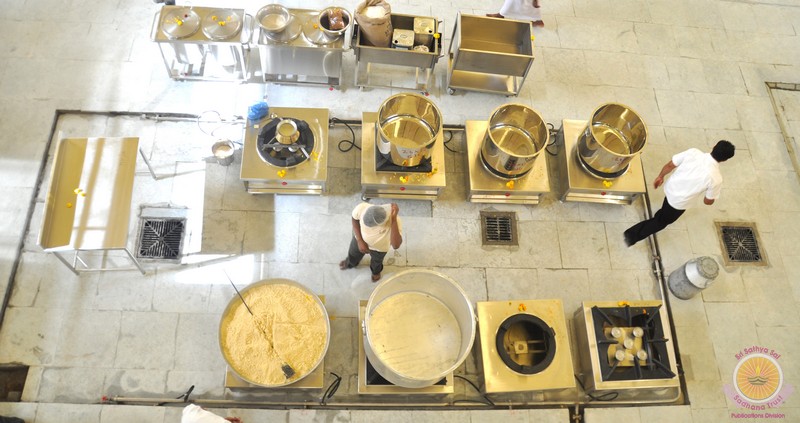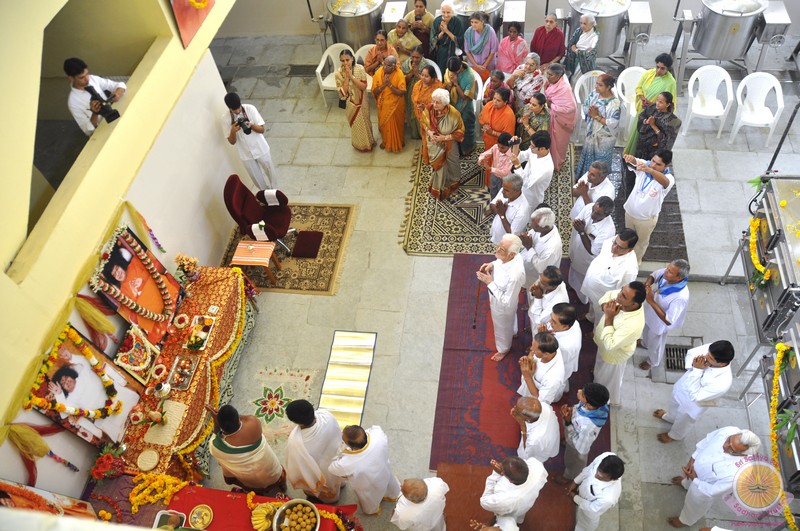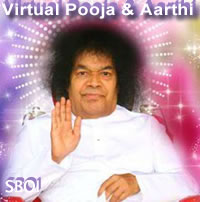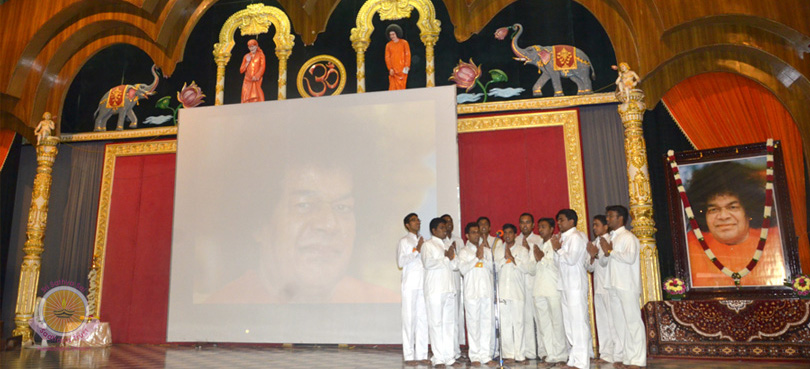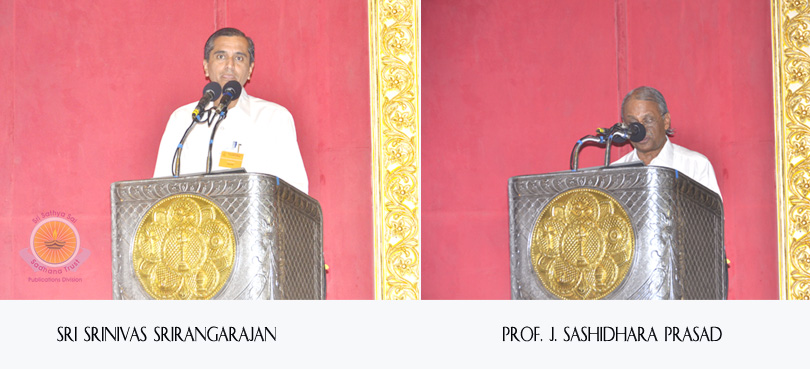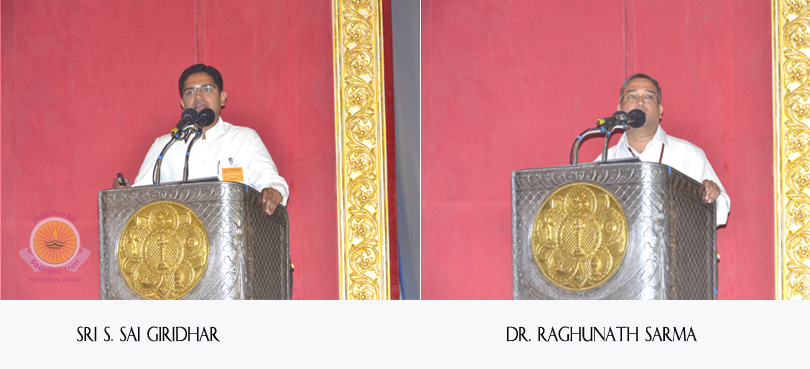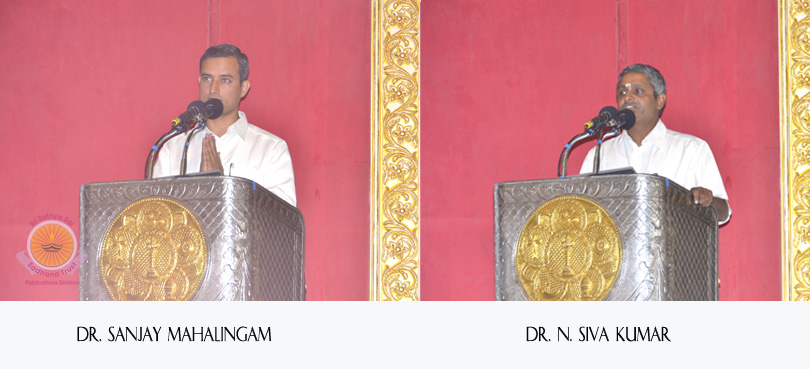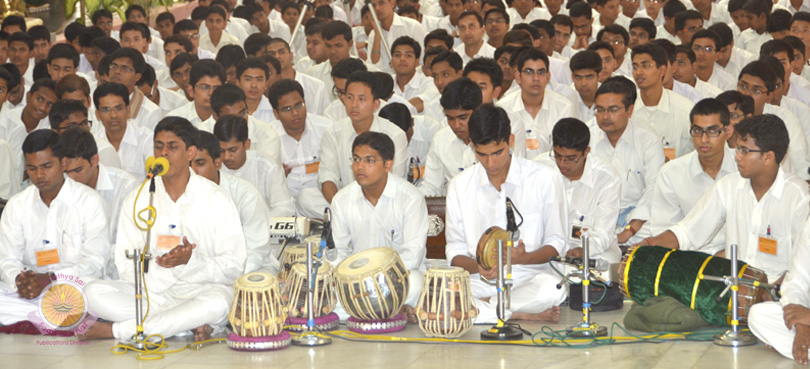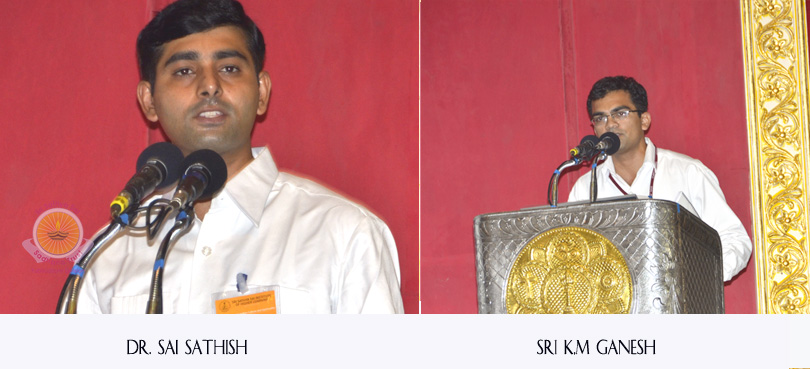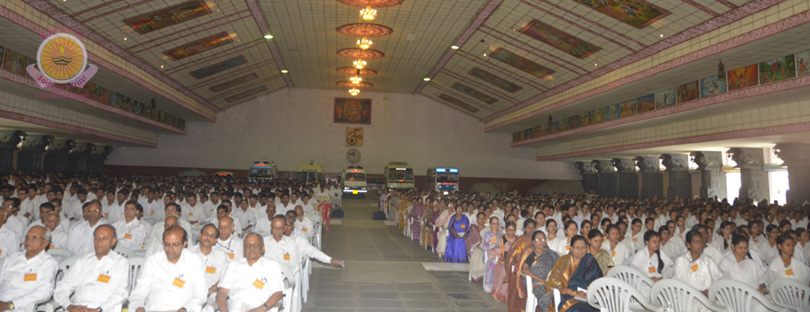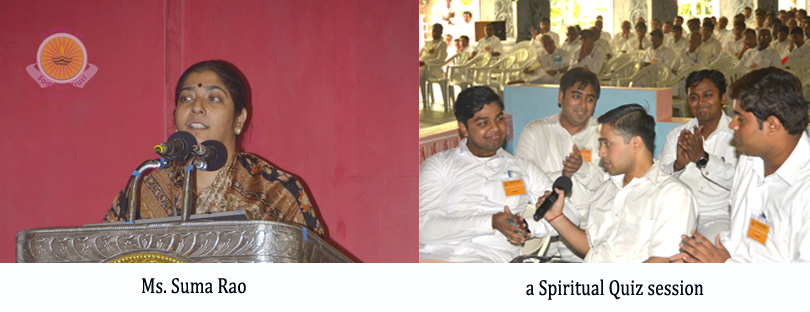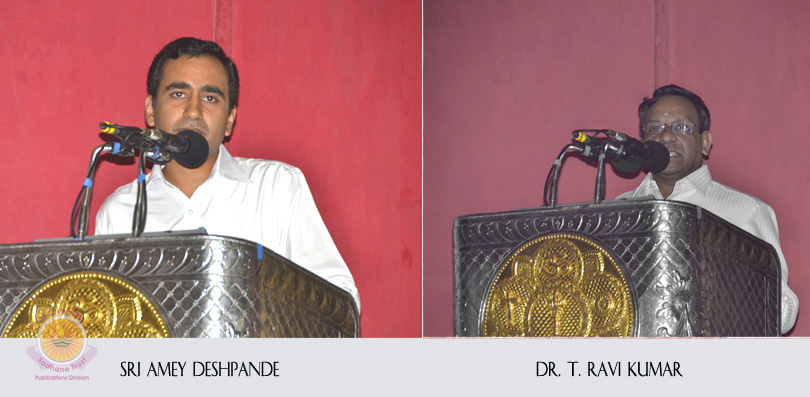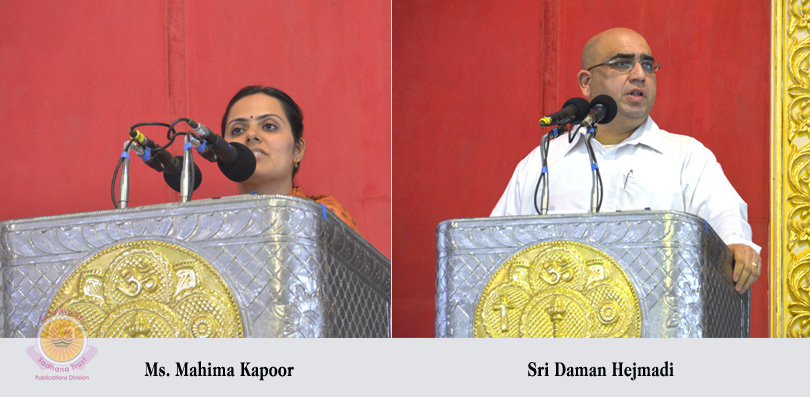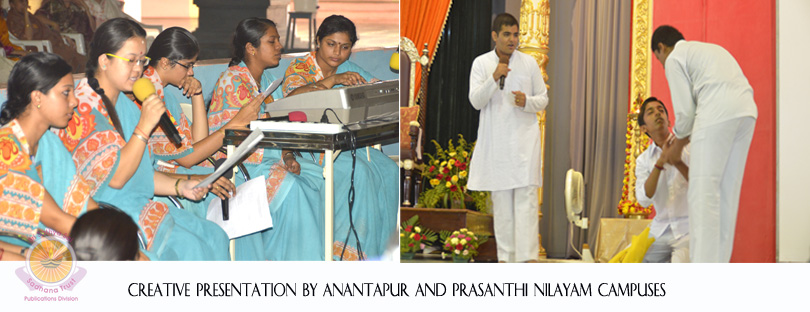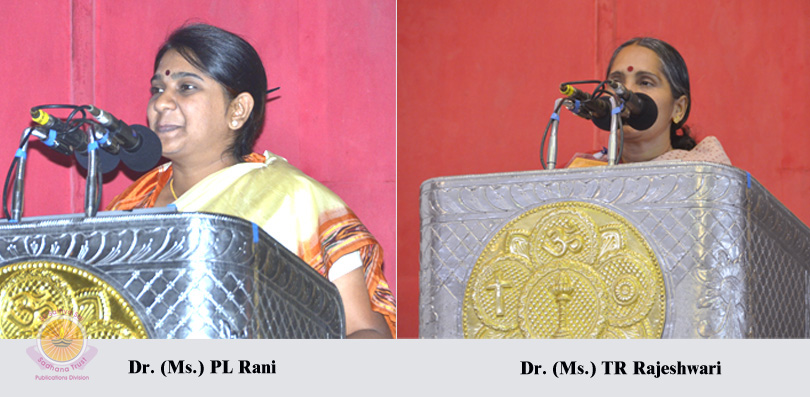|
|||
| Shirdi Sai Experiences | |||
|
|
|||
| Prasanthi this Week Friday, June 15th, 2012 |
|||
| Text & photo source - copyrights: Sri Sathya Sai Sadhana
Trust - sssbpt.org - Radiosai.org Prasanthi Diary - theprasanthireporter.org |
Web layout - Photo graphic design : saibabaofindia.com "SBOI" | - We gratefully
acknowledge the publishers Sri Sathya Sai Sadhana Trust & Sri Sathya Sai Media
Foundation |
|||
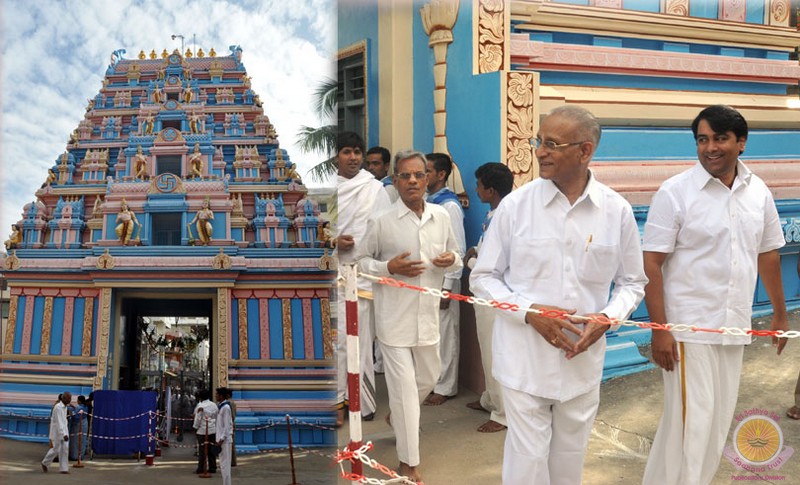 |
|||
| Also read: Summer Course in Indian
Culture & Spirituality – 2012 |
|||
|
Prasanthi Nilayam, the Global Township, as always balanced the ancient with the
modern this week with two note worthy events. The Gopuram Gate has now been
thrown open for devotees during the Darshan time in
Sai Kulwant Hall in the mornings and evenings. The Gopuram was built by devoted
hands in the South Indian style of temple architecture. The imposing and inspiring structure was inaugurated by Bhagawan on 18th November 1975, during the 50th Birthday celebrations. In 2010, the Kalasams, which form the finials of the Gopuram, were blessed by Bhagawan once again after they were polished in time for the 85th Birthday Celebrations.
The South Indian Canteen was renovated and restarted this week with all new equipment. A complete change in the ground plan of the kitchen, new flooring, cooking utensils and vessels are some of the modifications done. The new equipment included Rice Vessels with Gear Tilting Mechanism, Double Jacketed Steam Vessels, a variety of steamers to enable steam cooking of various dishes and pollution controlled burners using LPG in the place of diesel among others.
The inauguration function commenced with Gayatri Chanting at 0820hrs. Ceremonial Payasam was prepared in the midst of Vedic Chanting by Pundits. Trustees and the Secretary of the Central Trust and Sadhana Trust attended the inauguration even as the Canteen Manager invoked Bhagawan’s blessings. Arati was offered at 0905hrs and Prasadam was distributed to all who attended the function. There has also been a change of guard this week with Gujarat taking over from Uttar Pradesh for Sevadal opportunity this afternoon. As per tradition the outgoing Sevadal assembled in Poorna Chandra this afternoon after handing over charges to their Sai brothers and sisters from the land of the Father Of The Nation. They reminisced with an old Darshan video together as a single Sai Community. Later on they were addressed by the Secretary of the Central Trust and Organisational coordinators. Also read:
Summer Course in Indian Culture & Spirituality – 2012 |
|||
|
|
|||
Summer Course in Indian Culture & Spirituality – 2012Saturday, June 16th, 2012 Marking the commencement of the new Academic Year, a Summer Course in Indian Culture and Spirituality was organized by the Sri Sathya Sai Institute of Higher Learning (SSSIHL) from the 8th June to 10th June 2012 at Prasanthi Nilayam, participated by the students from all the four campuses along with faculties and staff members. The programme was modelled on the Summer Course in Indian Culture and Spirituality that the Revered Founder Chancellor, Bhagawan Sri Sathya Sai Baba had initiated in 1972. These Summer Courses continued intermittently for sixteen years until 2002. Popular known and published in book format as “Summer Showers in Brindavan”, the highlight of these Summer Courses was the series of discourses that Bhagawan would deliver on the essential teachings and ideals of the rich heritage of ancient Indian Culture & Spirituality. In early 2011, Bhagawan blessed that the Summer Course be re-initiated in a similar format over a period of two-and-a-half days for all internal stakeholders of the Institute – students, teachers, scholars and staff. It is now an annual event at SSSIHL in the beginning of each academic year. Format of the Summer Course The morning sessions of the event consist of talks by teachers and research scholars of the Institute. Typically, they entail key insights and lessons from the ancient Indian scriptures (such as the Mahabharata and Ramayana), spiritual figures and concepts. The sessions also feature a short video show on Bhagawan Sri Sathya Sai Baba. In the afternoons, students and teachers from all four campuses have breakout sessions where they discuss teachings and lessons from Bhagawan’s discourses. Key moral messages from these are creatively presented on the final day before the valediction. This year, the theme was Bhaja Govindam, based on the 1972 Summer Course discourses that Bhagawan delivered. The evening sessions on the first two days of the event consists of a music programme by students of individual campuses, along with Vedam chanting and Bhajans in the Mandir. Given below is a daily report of the entire event. Day 1 – Friday, 8 June 2012 Morning Session: (Four Talks and a Video Presentation) The SSSIHL Summer Course in Indian Culture and Spirituality 2012 commenced at 8:30 a.m. at the Poornachandra auditorium by invoking Bhagawan’s blessings through the chanting of vedic hymns by the students of SSSIHL.
Following the welcome address delivered by Sri Srinivas Srirangarajan, the Controller of Examinations, SSSIHL, the Vice-Chancellor of the Institute, Prof. J. Shashidhara Prasad delivered the welcome note, in which he stressed the importance of imbibing the values systems propounded by the Bhartiya culture, and putting into practice the teachings we have received from Indian scriptures and from Bhagawan Himself.
The first speaker for the day was Sri S. Sai Giridhar, Doctoral Research Scholar, Dept. of Chemistry. Sri Sai Giridhar spoke on the topic ‘Ramayana: The key to be near and dear to God’. The speaker narrated how in 2007 in Kodaikanal, Bhagawan expounded the qualities of five particular characters in Ramayana that made them very dear to Sri Rama. These included mother Kausalya, for her innate divinity; Vaidehi, for a mind tuned totally to the divinity of the Atman; Ahalya, for her patience, perseverance and willingness to be transformed; Hanuman, for his constant integrated awareness; and Bharata for his supreme devotion to the Lord. The second speaker, Dr. Raghunath Sarma, Asst. Professor, Dept. of Mathematics and Computer Science, spoke on the topic: ‘Insights from Mahabharata’. He brought forth the inner meaning of several anecdotes from the great epic, and urged each one to develop faith, whilst surrendering entirely to the will of God.
The two talks were followed by a video presentation, reminiscing the days in which Bhagawan walked the Sai Kulwant hall and granted Divine Darshan to devotees. This was followed by the third talk of the day by Dr. Sanjay Mahalingam, Senior Systems Administrator, Prasanthi Nilayam Campus, who spoke on ‘Vedas: The Breath of God’. Dr. Mahalingam reminded everyone that the Vedas are not mere books, but the very essence of reality – both the physical and metaphysical – that envelopes space and creation. He also added that the Vedas are accessible to each one of us, for they spring forth from within us. The only sadhana that one needs to undertake to unravel these mysteries is to develop silence. A silent mind is tuned to the Cosmic Consciousness and as Bhagawan often reminded us, it is only in the ‘depths of silence that the voice of God can be heard’.
The last speaker for the day was Dr. N. Siva Kumar, Asst. Professor, Dept. of Commerce, SSSIHL. Dr. Siva Kumar spoke on the topic ‘Lessons for Life from the Upanishads’. Dr. Kumar delved deeply on the etymology of the Sanskrit word ‘Upanishad’, explaining that the word is a combination of three root-words: ‘Upa’ meaning near, ‘ni’ meaning down, and ‘shad’ meaning sit. He further explained that the way to wisdom and knowledge was to be near to the Guru (signified by the first word ‘upa’), accept the teachings with humility (signified by ‘ni’), and maintain equanimity and stability under all circumstances (‘shad’). He concluded his talk by offering a prayer to Bhagawan to take each one of us from ignorance to wisdom, from untruth to Truth. Afternoon and Evening Sessions: (Study Circle, Mandir– Vedam, Bhajans & Music Programme and Parayanam Sessions) The post-lunch session comprised of a Study Circle consisting of discussions on the Discourses given by Bhagawan during the Summer Course held at Brindavan, Whitefield in 1973. They were based on the significance of Sri Adi Sankara’s Bhaja Govindam. The discussion was on four Discourses: an Anchor Discourse entitled ‘The ladder that enables an ignorant person to become a liberated soul’, and three Auxiliary Discourses, namely, ‘Human life is sacred – Do not waste it’, ‘The Present is the most sacred of all time’, and ‘God is known by a thousand different names.’ Students from all four campuses of SSSIHL were divided into several groups numbering 20-22, with each group consisting of 3 sub-groups. There were elaborate discussions between the students and the teachers/facilitators. The students showed active participation by coming up with relevant quotations, anecdotes, poems, etc. These not only provided an impetus to the enthusiasm and energy of the youth, but also served the purpose of driving home the meaningful lessons of life that the Discourses promoted. The Anchor Discourse highlights the comparison of the Bhaja Govindam to a ladder that helps us reach our destination. The lowest step is the stage of the Moodhamati or the ignorant one, with the highest step represents the Muktamati or the liberated one. Between these two are the twenty-nine steps or verses of the Bhaja Govindam, which, on deeper understanding, dispel our ignorance. In the Discourse, Bhagawan stresses on the continuous utterance of the Lord’s Name so that when the end is near, we may leave the body with the Holy Name. Sankara, on his travels all over India, came across a Moodhamati, a foolish Brahmin, who was busy trying to master the rules of Grammar in order to earn his livelihood to provide for his family. At that time, Sankara cautioned him, saying that when one’s death is drawing close, the rules of Grammar will not help him achieve liberation from birth and death. The only way by which man may attain liberation is by worshipping Govinda. The students supplemented this with a Chinna Katha narrated by Bhagawan. A man gave his sons the names of the Lord so that he may utter the holy name in his last moments. But, on his deathbed, he failed to do so as his worldly concerns overpowered the thought of the Lord. The first auxiliary Discourse reflects on the rarity and sacredness of human birth that is attained after accumulating many good deeds in previous lives. To justify this gift from God, we should recognise that the same divine Atma exists in all, thus dispelling our ignorance. Just being born as a human is not enough. One has to strive to transform oneself from an ignorant person to a Paramahamsa, and the easiest way to do this is to be in Satsanga, that is, good company. In the second auxiliary discourse, Bhagawan urges students to make the best use of the present, as it is the most sacred of all time. Upon enquiry from the participating students as to how they would make optimum use of their time, a large number of them said that service to one’s parents and chanting the Lord’s Name are the most fruitful. They also cited the examples of Pundarika and Prahlada who devoted their time to service and namasmarana (chanting the name of God), respectively. The peak of motivation and zeal was seen when the students came up with relevant stories to make the understanding of the values beneficial. In the third Auxiliary Discourse, Bhagawan clarifies the concept of positive thinking. It is said, ‘Yad Bhavam, Tad Bhavati.’ Every person views an object from his or her perspective. The appearance of the world conforms to the colour of the glasses worn. If green spectacles make the world appear green, red ones make it appear red. Optimistic thinking enables one to acknowledge only the good in the world. So, it is we who make the world around us what it is. Bhagawan reiterates the need to understand that all the forms of God are one and the same. Furthermore, many of us believe in God if our desires get fulfilled, but lose faith when our life goes contrary to our wishes. The various groups of students agreed that it is important to be equal-minded at all times, and that personal considerations should not be the basis for understanding the truth about God. The four Discourses made us realise that it is ego that veils clear thinking. Ravana had mastered all the Shastras (scriptures). There was no science unknown to him. In fact, Bhagawan said that Ravana was the greatest scientist ever. But, unfortunately, his ego overpowered him so much so that he failed to recognise the divinity in Lord Rama. The whole session resulted in endowing the students with values that they can practice in daily life. The Summer Course has, thus, been an enriching experience for the academic year 2012-13 as it leaves the students with value-laden minds, prayerful hearts, and energy channelised towards the welfare of society.
After a tea break, students assembled in the Sai Kulwant Hall by 5 pm. Following Vedam Chanting, there was a summary presentation by students after which, there was a music programme by the students of the Brindavan campus of the University. After Dinner, the four campuses met separately and continued the much sought after Satsanga, talking about individual experiences with Bhagawan. Day 2 – Saturday, 9 June 2012 Morning Session: (Three Talks, a Quiz and a Video Presentation) The first talk this morning was delivered by Dr. R. Sai Sathish, Asst. Professor, Dept. of Chemistry. Dr. Sathish spoke on the subject, “Insights from the Srimad Bhagavatham.” He began by saying that it is important to first answer the questions – ‘What is Bhagavatham?’ and ‘How did it come into existence?’ The Bhagavatham fills one with devotion, wisdom and detachment, and instills in us the urge for liberation. Beginning with Bhakti (devotion), the Bhagavatham culminates in the idea of Mukti (liberation). It is the repository of the experiences relating to God and the godly. The Bhagavatham came into existence as a result of Sage Veda Vyasa’s attempt (on the advice of Sage Narada) to cleanse his mind of the preoccupations with Prakriti (creation); and to focus on the Purusha (the One without attributes). When we contemplate on the good within, the same good gets projected outside as well. The Bhagavatham begins with the dialogue between Sage Suka and Emperor Parikshit who is cursed to die in seven days. Sage Suka counsels Parikshit on how to face death, the ultimate test of life. The speaker affirmed that, despite his noble birth, Parikshit got carried away by his anger and brought the curse of Shringi upon him. During the seven days that King Parikshit spent in the company of Sage Suka, he was constantly immersed in the Bhagavatham. Therefore, at the end, he gained amanaska, freedom from the desires of the mind.
The second speaker of the morning session was Sri. KM Ganesh, Doctoral Research Scholar, Dept. of Chemistry. Sri Ganesh spoke on the topic, “Lessons from the Bhagawad Gita.” He delved into the meaning of Sanathana Dharma, which represents the imperishable, eternal truth. The speaker said that the Bhagavad Gita is a textbook of sadhana, which prescribes different types of yoga. However, the practice of the teachings is more important than the teachings themselves, he said. In this manner, sadhana brings us closer to God. In the initial stages of sadhana, we may face certain difficulties,however, with persistence, we will find greater ease in doing sadhana. If the mind remains in the Divine Presence, that is, focused on God, the chaos that surrounds us constantly will cease to affect us.
Towards the end of his talk, Sri Ganesh spoke about the Gita’s message regarding the need for detachment and surrender, and the importance of choosing right from wrong. This was followed by a special video show that was a compilation of select excerpts from Bhagawan’s Discourses. Although Bhagawan speaks in public, He reaches out to each and everyone at a personal level. In the five video clips presented, Bhagawan, through familiar analogies, explains how the mind can be disciplined, how one may atone for one’s sins, experience the highest love, and control one’s anger. The third speaker of the morning session was Ms. U. Suma, Asst. Professor, Dept. of Commerce. Ms. Suma began her very interesting and illustrative presentation on ‘The Law of Karma’ by saying that Karma refers to both the action and the consequences of action. Therefore, she compared it to a boomerang. Every action that commit to, generates a force of energy that returns to us in equal measure. The stored Karma that is worked out by an individual, in life after life, is called Sanchita Karma; whereas the Karmic consequences from past lives that affect us in the present are called Prarabdha Karma; and the present Karma which is bound to affect the future is Aagaami Karma. The speaker emphasized that, unlike common belief, the theory of Karma is built on a great deal of positivity. It is the pathway to evolution. The Law of Karma empowers us with choice. We have a choice to deal with Prarabdha Karma by bearing it stoically, transmuting it or transcending it. But, the best solution to avoid all the effects of Karma is to engage in Nishkama Karma, in which, the individual renounces the fruits of the action, and not the action itself. This may lead to perfect action that arises from objectivity and balance.The speaker took the example of True Art to explain this point. True Art requires objectivity; that is, drawing what one sees and not what one knows. It also demands a holistic vision. The same is true about life. In the concluding part of the talk, Ms. Suma answered some of the questions of skeptics; questions such as ‘Why do bad things happen to good people?’, ‘Doesn’t the belief in the Law of Karma make one passive?’, and ‘Is there a way out of the Karmic cycle?’ For the last question, as to whether there is a way out of the Karmic cycle, Ms. Rao referred to Bhagawan’s Discourse in which He says, “Even a mountain of sin can be wiped out by winning the grace of the Divine.” Grace can nullify Karmic effects.
The morning session ended with an enterprising Inter-Campus Quiz Programme conducted by Dr. Shashank Shah, Post Doctoral Fellow, Dept. of Management Studies and his team. The Quiz consisted of 7 rounds: the Ramayana, the Mahabharata and the Bhagavad Gita, the Bhagavatham, the Shad Darshanas and the Bhaja Govindam, a Visual Round on Bhagawan’s Life, an Audio Round on Bhagawan’s Discourses, and, finally, the last round on Bhagawan’s Life and Message. The Quiz generated a lot of interest, and there was active participation from the audience as well. Afternoon and Evening Sessions: (Study Circle, Mandir – Vedam, Bhajans & Music Programme and Parayanam Sessions) In the afternoon, the respective campuses engaged themselves in campus-wise study circles based upon the four discourses of Bhagawan described earlier. The discussions on the first day were concluded today by presentations by the students in the form of skits and one act plays, which helped absorb many insights into the great Indian Culture and the spiritual aspects of many a great Epics in the most coherent form. The students felt that in today’s materialistic world, there is a general notion that spirituality is a completely different path that one has to walk only at a later stage in his/her life (when one has achieved all the worldly things possible). The question that then arose was that, ‘why not have a similar strategy for sleeping, eating and other such activities of our daily lives’? They deciphered that just like we cannot compartmentalize these activities, in the same way, spiritual and the worldly activities have to go together in perfect unison in one’s life. They felt grateful that the Summer Course was helping them understand the practicality of spirituality. The students felt that the motto of our University, “Satyam Vada, Dharmam Chara”– Speak the Truth and follow Righteousness is nothing but practising of Human Values which form the basis of a spiritual life. Quintessence of Swami’s message in the Four Summer Course Discourses: In the Four discourses that were discussed by students, Swami has highlighted some of the most illuminating and profound messages of Bhaja Govindam composed by Sri Adi Shankaracharya. The main ones include:
All students felt that we should be grateful to Bhagawan, Who, out of His immense love for us, has created avenues for us to understand and experiment different aspects of life. The students of Bhagawan should emerge as Beacons Of Light for the world with a continuous thought of the welfare of humanity with the feeling of “Samastha Lokaha, Sukhino Bhavantu” (May all the beings in all the worlds be happy). After tea, the evening session followed the same pattern as the previous day (Day 1). All students assembled in the Sai Kulwant Hall by 5 pm. Following Vedam Chanting, there was a summary presentation by students. This evening, the music performance was by the students of Anantapur Campus of the University. After Dinner, the four campuses met separately and shared their personal experiences with Bhagawan with one another. Day 3 – Sunday, 10 June 2012 Morning Session: (Five Talks, a Global Presentation, a Video Presentation and the Valedictory Session) The proceedings of the third and final day of the Summer Course in Indian Culture and Spirituality began with Veda chanting from the Holy Scriptures by students of the Institute at 8:30 am in the Poornachandra Auditorium at Prasanthi Nilayam. Sri Amey Deshpande, Doctoral Research Scholar, Dept. of Management Studies was the first speaker of the day who spoke on the topic, “Sai Avatar – The fountain-head of Indian Culture & Spirituality”. He began with defining culture as told by Swami. Swami defines culture as the process of refinement and also says, “The end of culture is perfection.” Several masters and saints that have graced humanity from time to time have shaped culture. Once in a while, the Lord Himself comes down to earth to show us the meaning of culture and point us in the right direction. He briefly elaborated on the five points that can be taken as the fundamental points of the Sanathana Dharma, which has shaped Indian culture and help us shape our refinement process. These include: Yadbhavam tad bhavati, vasudhaivakutumbakam, yogahakarmasukaushalam, sarve karma bhagvatprithyartham and sarvamkhalvidam brahma. He gave anecdotes from Bhagawan’s own life epitomising each one of these points. Each of those episodes highlighted how Bhagawan is the fountainhead of Indian culture.
Following this, the next speaker, Dr. T Ravi Kumar, Associate Prof., Dept. of Chemistry, and Warden, Brindavan Campus, SSSIHL spoke on the topic ‘Indian Culture and Spirituality: Insights from the life of Bhagawan Sri Sathya Sai Baba‘. At the outset, the speaker hailed Bhagawan as Bharatha Bhagya Vidhatha – the term by which a former West Indies Cricket Captain described Him. He then listed the various definitions of culture that are current and remarked that nothing captures the essence of culture as Bhagawan’s own definition, which is, ‘Culture is concern for others‘. The speaker – who has had the privilege of close proximity to Bhagawan for over three decades – then delighted the audience by narrating a number of personal anecdotes highlighting the concern Bhagawan has for all those who come in contact with Him. The gathering was then treated to a collection of video clippings of Bhagawan Baba from the old days. The collage – beamed to devotees on His 85th Birthday on 23 November 2010 – was in the form of three devotional songs composed in poetry form, sung by His students. From Darshan in various parts across India to the colossal socio-economic projects, to His tender Love and concern for each devotee and humanity at large, the video clips elicited a stream of wonderful memories in everyone’s hearts. The third talk of the day – a hard act to follow after a moving video presentation of Swami – was by Ms. P L Rani, Asst. Professor, Dept. of English Language & Literature. Given the tough assignment of simplifying the complex topic of The Eightfold Path of Patanjali Yoga Sutra, she began her exposition with an explanation of the three key terms ‘Patanjali’, ‘Yoga’ and ‘Sutra’. The speaker began with the sutra that defines yoga as yogahchittavrittinirodhah – yoga is that which helps to still the mind. Briefly touching upon the different kinds of thought-waves that cause fluctuations of the mind, she dwelt at great length, quoting the relevant sutras, on the practice of ashtanga yoga as a means to achieve this. Moral restraint, regular practices, right posture, regulation of breathing, withdrawal of senses from the outer world, attentiveness, meditation and supreme contemplation, which form the eight steps, were explained from a practical perspective with the aid of audio clippings of Bhagawan’s discourses on the same topic. The highlight of the talk came when the speaker, very imaginatively, delved on how the practice of the ashtanga yoga is so subtly embedded in the divinely and carefully designed routine of SSSIHL students’ lives in the hostel and on the Campuses. Indeed, the audience seemed enthused by the happy feeling that the integral system of education at the Institute is akin to the practice of the tenets of the ashtanga yoga in its very essence. The final speakers of the day were two alumni of the Institute. The intent was to help current students get a glimpse on how graduates of SSSIHL have consistently put into practice the invaluable teachings of the Revered Founder Chancellor and how the integral education system of the Institute has positively shaped their inner and outer lives. Both students spoke on the topics, an ideal Sai Student and his/her role in society. First up was Mrs. Mahima Kapoor. She recollected how she was very determined be called a “Sai Student” and it is only after graduation she realised how that tag comes with a fair bit of responsibility. She said that the disciplined and tough routine of the hostel and college, though bitter and frustrating at times, has directly impacted her daily life in a positive way. Ten years on, she realised how the strict rules have helped her deal with complex and challenging situations in her adult life – both personally and professionally. She described in particular a couple of moral situations in her professional life where she had the courage to follow the truth and be honest at all times.
The next speaker was an alumnus from the early days of the Institute, Sri Daman Hejmadi. He fondly recollected how in his days, students would ask Swami for every small doubt they had. He briefly described how the ‘life skills’ that students of SSSIHL learn are very different from the transient skills that are acquired in one’s professional life. The dictum, Education is for life, and not for a living that Swami often elaborated upon and what all students learn during their time, had helped him in a myriad of ways. Some of these, he said include cooking, waking up early at 5 am, simple living (vs. luxurious living), and general resourcefulness that the Self Reliance activities of the Sri Sathya Sai Hostel teaches students. He then gave examples from his professional life as to how the lesson of Life is a game, play it that he learnt during his time as a student has helped him be generous, create win-win situations and maintain equanimity in good times and difficult ones. He ended his talk with a personal example of how Bhagawan had directly guided him in His physical form in the United States and asked him to move back to India. Collective Presentation by students from all campuses The end of the Summer Course 2012 was nearing, but not before a Global Presentation by all the students of all four campuses, as well as the XI and XII Standard (Boys and Girls wings), Sri Sathya Sai Higher Secondary School. This creative extravaganza, was in essence, a presentation of the collective learning of the key moral and life lessons from Swami’s discourses deliberated upon during the Study Circle sessions conducted by all campuses and the school students during the course of the Sumer Course. It was presented in two parts – first by the girls of the Anantapur Campus and XI and XII Standard (Girls wing) girls, followed by the boys from the school and all the men’s campuses.
Surrender to God (and taking refuge in His feet – literally the key theme of the Summer Course 2012 – Bhaja Govindam), the importance of spiritual inquiry, how material life is a prop to reach the higher goals of life, and the fact that God has embedded permanent gems of ideals in an impermanent body (for us to discover the higher purpose of our lives); these were some of the subtle but powerful lessons highlighted by the women students during their narrative. The men’s students started their presentation with a skit based on a popular analogy that Bhagawan often narrated about the attitudes between Duryodhana (who sees bad in all people except himself) and Dharmaraja (who cannot see anything but good in people except himself) when asked by Krishna to find one good person (to Duryodhana) and bad person (to Dharmaraja). This was in the Dwapara Yuga. The skit then highlighted how in the current Kali Yuga, negativity in men has multiplied manifold (full of fault-finding in others). Other skits included moral dilemmas between friends in a professional situation and the enduring dedication of Hanuman (in the scripture Ramayana) to do anything to be close to Lord Rama. Lastly, a satire from the fictional life of a man called Bhola (unlearned, foolish but extremely sincere) highlighted the universal message of our Lord Sai that God is everywhere and in everyone. Felicitations – A moment of thanksgiving: Each year, senior faculty members (often after decades of dedicated service) retire and new faculty members take their place, whilst others are promoted. The Academic Year 2012/13 was no different. Dr. Naren Ramji, Registrar, SSSIHL presided over the ceremony and reminded everyone of the main quality Bhagawan has taught us all by His own personal example – that of gratitude. The two main outgoing faculty members facilitated for their outstanding service and contribution for thirty-three long years to SSSIHL and Bhagawan’s mission were Prof. G Balachandran, Dean, Faculty of Economics and Humanities and Prof. S. Krupanidhi, Dean of Sciences. This was followed by the announcement of new faculty members who joined SSSIHL during the current academic year and current members of the fraternity who have been promoted to higher designations in their respective departments. Valedictory Session: The Valediction to the SSSIHL Summer Course in Indian Culture and Spirituality 2012 was led by Dr. (Ms.) TR Rajeshwari, Associate Prof., Dept. of Commerce. Drawing parallels to how Michelangelo sculpted beautiful pieces of art from masses of rock, Ms. Rajeshwari echoed, that Swami expects us to chisel out the negative gross matter (ignorance) and bring out the good virtues within us, which are already there.
Ms. Rajeshwari reminded everyone how the system of education at SSSIHL provides the platform to shape students’ lives in accordance to Bhagawan’s teachings and help them evolve, and make the correct choices in life. This however necessitates that we are empty (from inside), open to learning and have readiness with the correct attitude. Along with thanking various factions for making the event successful, the speaker concluded in recapping how the three-day event had served as a wonderful reminder to the fortune that all the students, teachers and staff have, of being part of this unique institution and prayed that all of them endeavour of being worthy of His tremendous, unconditional Love. II Samasta Lokaha Sukhino Bhavantu II
|
|||
